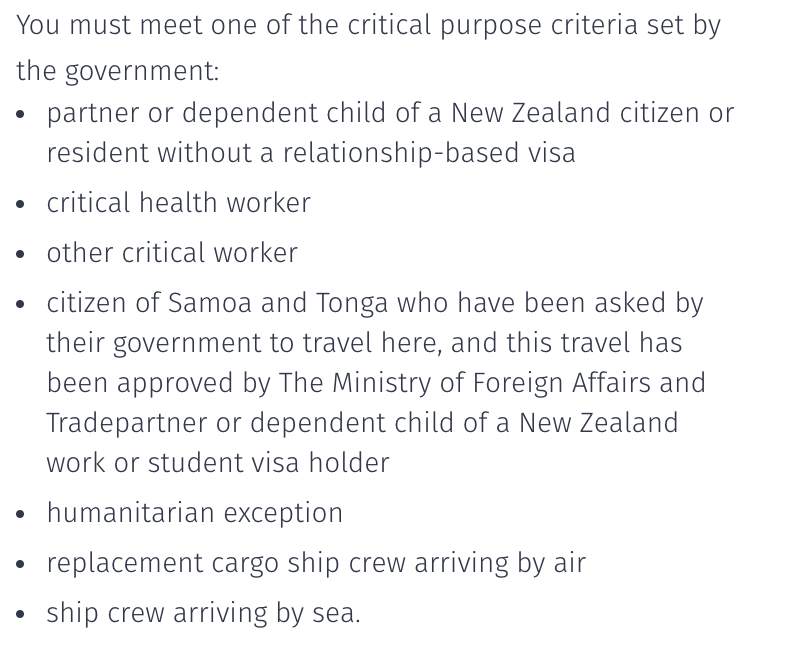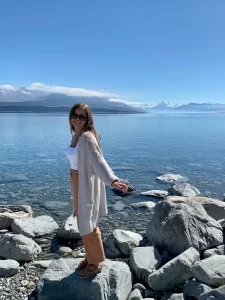A Critical Purpose Visitor visa, or CPVV, is a new visa category in New Zealand. It allows people with a “critical reason” for being in New Zealand to enter the country despite the recent border closure. In this post, I’m going to explain how to get a Critical Purpose Visitor visa in more detail.
Disclaimer: I am not a lawyer. Nor am I any kind of immigration expert! I’m just a girl that has gone through this same process before. I’m writing this post to hopefully help others who are looking for more information like I was. Since this is such a new process, it can be hard to find relevant information and tips all in one place. Things can change very quickly, so make sure you double check all requirements before you submit.
Personally, I didn’t receive any help from a lawyer or immigration advisor before submitting my application. It’s definitely possible to get approved on your own if you’re diligent. However, it’s a good idea to get professional help if you’re confused about the requirements or are in an unusual partnership situation.
Before applying for a Critical Purpose Visitor Visa
Are you eligible?
The criteria for being allowed entry are pretty strict. Immigration NZ allows for the following categories to apply:

I fell into the first category (partner of a New Zealand citizen). I’ll be focusing the rest of this post on that category as it’s the only one I have experience with.
Invitation to apply

Before you can apply for the actual visa, you need to receive an invitation to apply. To get one, you need to fill out a request for travel to New Zealand. This form lets you give a short description of your circumstances and reasons for wanting to enter the country. You enter your passport details and partner’s information, as well as answer a few questions about health and character. It costs NZ$45 to submit.
Until recently, the New Zealand government has only accepted these requests if the kiwi partner was physically with their separated partner. This caused many couples to go on “fetching” missions – the NZ partner having to fly and “collect” their partner, then applying for this visa and traveling back to New Zealand together. Now, the government is approving requests from partners in visa waiver countries without having to fly and fetch. If you’re not from a visa waiver country, it unfortunately looks like your invitation to apply will not be approved unless your partner is physically with you.
Immigration NZ will send you an email to let you know if they’ve decided to extend an invitation to apply. It is generally a quick process – my invitation took about 12 hours to arrive, although it can take up to a few days.
What you get
An approved Critical Purpose Visitor visa allows you to stay in the country for either 6 or 12 months. Mine was approved for 12 months, and I’m pretty sure that’s because I made it clear that I would be applying for a second visa onshore. An approved CPVV is good for one time entry into the country unless you receive multiple entry travel conditions. You can change the length and entry conditions of your visa by applying for a Variation of Conditions.
Critical Purpose Visitor Visa application tips
There are several categories of criteria you have to fill out to get a Critical Purpose Visitor visa. There is space to upload your documents on the last page of your application. I’ll describe each category and give a few tips for applying below.
Evidence of funds

In this category, you have to show that you have enough money to sustain yourself throughout the length of your visa. For a visitor visa, you need to have NZ$1000 a month, or NZ$400 if your accommodation is already paid for. If you don’t have enough money, you need to have your partner (or someone else) fill out a sponsorship form saying that they will support you during your stay.
I uploaded screenshots of bank statements from my savings account, checking account, and available credit amounts on all of my credit cards. Make sure that you include the last few months’ worth. These same screenshots can also be uploaded to the “Funds for travel” section.
Identity

This category is easy enough: you need to prove your identity. When applying online, you need to upload one acceptable photo. This photo is similar to a standard passport photo and can be taken professionally or at home. I had my partner take a picture of me against a plain wall with my phone. Make sure you double check what constitutes an acceptable photo before taking it if you choose to do it yourself. There are certain specifications that you must follow.
In addition to a photo of yourself, it helps to add scans of any official forms of identification you have. I added my driver’s license, birth certificate, passport, and government-issued FAA card. You can add these under their respective categories or under “Other evidence of identity.”
Health & character

You must be in good health and of good character. If you are planning on staying in New Zealand only for the maximum 12 months of this visa, and you’re coming from a country with a low incidence of TB, you do not need to include any supporting documents here.
(In my CPVV application, I included a scan of my health insurance card under “Medical insurance confirmation.” Although not necessary, it does help prove that I’m not coming into the country to get medical treatment.)
However, if you’re planning to stay in New Zealand for longer, you will need to get a chest X-ray from an approved physician and a police certificate from any countries you are a citizen of or have lived in for longer than 5 years. You can include these in your CPVV application if you’re planning to apply for another visa once in New Zealand (this will save you time in the future).
Genuine intentions

You must genuinely intend to meet the conditions of your visa. This means that you’re coming into New Zealand to be with your partner and that you aren’t planning to overstay the terms of your visa. In other words, you must show that you are a “genuine visitor.” There are several ways to show proof of this:
- Evidence of your travel history: I included a scan of all of my passport pages. This would show Immigration that I haven’t ever overstayed any of my previous visas.
- Evidence you’re visiting friends & family: you can include any contacts you have in New Zealand. This section isn’t as important since you’re applying on the basis of your relationship anyway.
- Evidence of your home country circumstances: in this section, Immigration NZ wants to see that you have connections to your home country that make you more likely to return. I included a furlough letter from my employer showing that I will have a job to return to in the future.
Proving that you’re a genuine visitor can seem a bit confusing if you actually intend to make New Zealand your permanent home. I included a letter explaining that if approved, I intend to apply for another visa once in New Zealand. In that letter, I also explained that if I don’t get approved for a second visa, I am able and willing to return to the US before my CPVV expires. To prove that, I included a screenshot of my savings account to show I have the funds to purchase a plane ticket home if needed.
Critical purpose
This is probably the most important section when applying for a critical purpose visitor visa as a partner. Under this section, you should include any solid evidence that you and your partner:
- are in a genuine, stable relationship
- are living together or have in the past
- share finances, etc.
It’s important to note that you should only include concrete evidence here. For example, uploading a screenshot of a shared bank account is going to be worth more than uploading a letter from a friend saying you’re a legitimate couple. Aim to have more concrete evidence than subjective evidence.
I’ll go over some specific examples of evidence I posted below.
Genuine and stable relationship

Evidence for this section could be in many forms: a marriage certificate, proof that you have children together, joint ownership of property, etc. As we didn’t have any of that, I got a bit creative with my evidence.
For this section, I created a (rather cheesy) Google Doc outlining the entire history of our relationship. I wrote small blurbs about how we met, places we’ve traveled together, and specific lengths of time we’ve spent in each other’s country. I made sure to include pictures of us with friends and family to show that our relationship is recognized by other people.
As a flight attendant, my partner is on my travel benefits. I included screenshots from my company’s website showing travel logs of our trips together going several years back. I also included a screenshot of the NZMCA website which showed a membership card with both of our names.
Lastly, I included a few screenshots of conversations we’ve had while apart. You can download entire text files of chats on Facebook Messenger or WhatsApp, but I thought that would be a bit overkill. I picked a few of the sappier “I love you” messages and some screenshots of longer video chats we’d had.
Living together

In this section, you should include any official documents showing that you’ve lived together. This could be a lease agreement, evidence of rent payments, or letters addressed to the two of you at the same address.
My partner and I had never “officially” lived together before I got approved for my visa. We would spend lots of time together traveling and staying with each other’s families, however. I included a letter explaining this situation and that if approved, I intended to move into his house.
Although people say it is usually quite important to have proof of living together, it is definitely still possible to get approved without it if you have strong evidence in the other categories. If you and your partner have no proof of living together, make sure you include lots of other evidence that your relationship is genuine.
Share finances

The easiest way to prove this is to upload a screenshot of a joint bank account. In my case, we had never lived in each other’s country and had not opened a bank account together. When going to activities or events with our friends, our arrangement was that he would pay for me while I was in New Zealand and I would pay for him in the United States.
To prove this, I uploaded several screenshots from the money sending app Venmo. I included transactions from over the years from several different friends. The descriptions showed that my friends were charging me for his part. These screenshots showed evidence that other people recognize our relationship and that we share finances.
After submitting your Critical Purpose Visitor Visa
Waiting time

Immigration NZ approved my visa in exactly two weeks. I’ve heard of it taking anywhere from three days to a few months, so don’t get discouraged if it’s taking longer than you expect. If you’re worried, you can always contact an immigration officer to ask about the status of your application. Your confirmation email lists a contact phone number.
Adding more information
After submitting your application, you’re able to add more information as you see fit. If you suddenly remember a piece of evidence that could be useful, you simply go to My applications > Submitted > Upload documents.
Sometimes, you could get an email from Immigration asking you to clarify something before they’re able to approve your visa. If they contact you, make sure to upload the additional information as soon as possible. After submitting my application, I didn’t receive any kind of contact from Immigration until they sent me an email saying I was approved.
Approved for a CPVV – now what?

Congratulations! Now that the government has approved your visa, you can think about getting to New Zealand. Make sure to check the terms of your visa (listed on the email) to see what date you have to enter the country by.
I have a whole blog post about the managed isolation process and what to expect when entering the country. Feel free to check it out to get a sense of how it all works.
Once you’re in the country, it becomes much easier to apply for a longer-term visa. A few popular options include the Partner of a New Zealander Resident Visa and the Partner of a New Zealander Work Visa. These two visas require you to have been living with your partner for a longer amount of time. It becomes easier to fulfill that requirement since you can prove that you’re together for the duration of your CPVV.
Love is not tourism

If you can, please think about supporting the #LoveIsNotTourism group. They are working hard to get governments around the world to loosen border restrictions for separated couples. Since their inception, they’ve already succeeded in getting a handful of countries to allow unmarried partners in on compassionate grounds.
Good luck on your application process! I know applying for a critical purpose visitor visa can be confusing. If you have any questions, please leave them in the comment section below.
xoxo Niki



Hi Niki,
That is a detailed explanation of each and everything about CPVV which I was searching for days. Helped me a lot…Good job👏👏👏
Awesome! Glad it helped 🙂